A practical guide to bird watching in Sonoma County, California
(Unless otherwise indicated, all phone numbers are in the 707 area code)
A practical guide to bird watching in Sonoma County, California
(Unless otherwise indicated, all phone numbers are in the 707 area code)
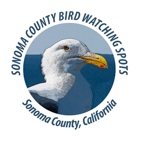

Those who aren't paying attention often lump crows and ravens under the general heading of "crow," but these are different birds--and not that hard to distinguish once you know what to look for. That said, they can be confusing, and sometimes it's hard to get a good enough look to tell them apart. In that case, you can call your bird a corvid and leave it at that.
Opinions will differ, but in my view, the best way to distinguish ravens and crows is by looking at the bill, when visible, or at the tail when in flight. Common Raven has a stout, strong-looking bill usually overlapped about halfway or more with heavy bristles (see photo below). American Crow (Corvus brachyrynchos) has a more slender, more pointed bill. Ravens will often have a scruffy look at the throat. They are considerably bigger birds than crows. They have much deeper, raspier voices (in fact, voice is often enough to distinguish cooperative birds that call; ravens croak, crows say "kaw!"--most of the time, anyway).
Ravens have proportionately longer wings, often with more clearly divided primaries that give the look of splayed fingers in flight, although crows can have the "splayed finger" look as well. The raven's tail is a rounded diamond-shape seen from below, that of the crow a narrow fan. (Note, however, that when folded, a raven's tail can look like a fan as well. It pays to watch carefully as the bird flies and as the shape of the tail changes.) This and other aspects of the silhouettes are very useful; it's worth getting to know them (see below).
Crows rarely soar. Ravens commonly do--with flat wings that can make them look like hawks at a distance. Ravens are more commonly solitary than crows, which often move in groups, sometimes of as many as 100 birds or more, but ravens, too, form flocks and occasionally hunt together. Birds in urban or suburban settings are more likely crows. Ravens more often are present in hilly or even mountainous terrain, but may be anywhere in the county, although less commonly in the southern extreme, near San Pablo Bay. Crows and ravens usually do not associate with one another. In fact, it's not uncommon to see small groups of crows harassing ravens.
Trivia: Common Raven is the world's largest passerine (order Passeriformes).
Voice: Cornell Lab of Ornithology: All About Birds--Common Raven
Voice: Cornell Lab of Ornithology: All About Birds--American Crow
© Colin Talcroft, 2009, 2010, 2011, 2012, 2013
Unless noted, all photos by the author. If you would like to use one of my images, please ask for permission for non-commercial use with proper credit or commercial use with proper compensation.
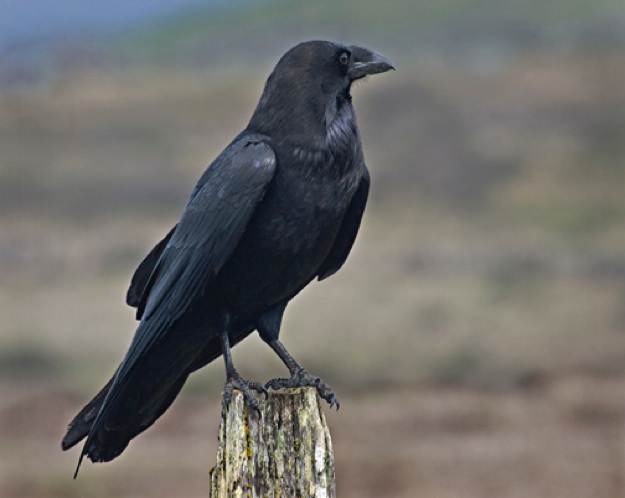
American Crow
Common Raven
Near Duncan’s Landing, March 9, 2011
Common Raven
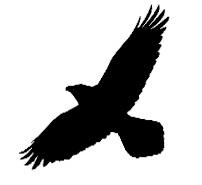
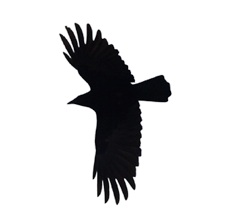
For comparison: American Crow
Lake Ralphine, Santa Rosa
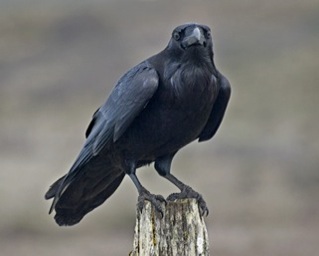
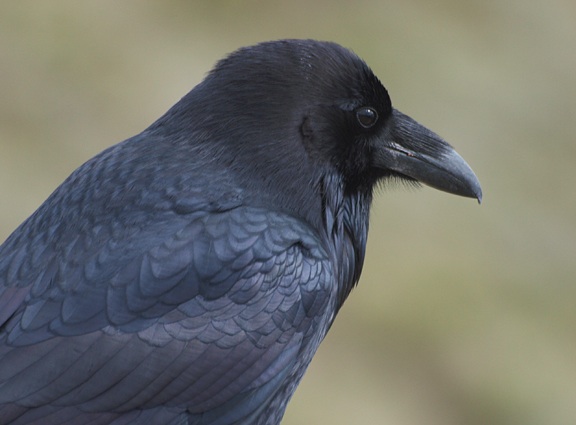
Common Raven, November 5, 2011
Note the long tuft of bristles extending halfway down the bill
Common Raven, near Duncan’s Landing, March 9, 2011
Common Raven
Corvus corax
1990-2013 Sonoma County data. Graph provided by eBird (www.ebird.org), generated May 30, 2013
EBird reported occurrence in Sonoma County

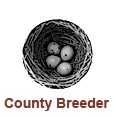
Further reading:
Bolander and Parmeter, Birds of Sonoma County California, rev. ed., 2000, p. 88
Brinkley, National Wildlife Federation Field Guide to Birds of North America, 2007, p. 415
Burridge, ed., Sonoma County Breeding Bird Atlas, 1995, p. 115
Dunn and Alderfer, eds., National Geographic Field Guide to the Birds of North America, 5th ed., 2006, p. 326
Dunn and Alderfer, eds., National Geographic Field Guide to the Birds of North America, 6th ed., 2011, p. 364
Dunne, Pete Dunne’s Essential Field Guide Companion, 2006, pp. 450-451
Ehrlich, Dobkin, and Wheye, The Birder's Handbook, paperback edition, 1988, p. 420
Fix and Bezener, Birds of Northern California, 2000, p. 267
Floyd, Smithsonian Field Guide to the Birds of North America, 2008, p. 321
Kaufman, Field Guide to Birds of North America, 2000, p. 278
Kaufman, Field Guide to Advanced Birding, 2011, pp. 21
Lukas, Bay Area Birds: From Sonoma County to Monterey Bay, 2012, pp. 91, 194-195
Parmeter and Wight, Birds of Sonoma County California, Update (2000-2010), 2012, p. 52
Peterson, Birds of Eastern and Central North America, 5th ed., 2002, p. 252
Peterson, Field Guide to Birds of Western North America, 4th ed., 2010, p. 266
Peterson, Western Birds, 3rd ed., 1990, p. 252
Sibley, Field Guide to Birds of Western North America,1st ed., 2003, p. 309
Stokes, Stokes Field Guide to the Birds of North America, 1st ed., 2010, p. 508
Vuilleumier, American Museum of Natural History, Birds of North America: Western Region, 2011, p. 280